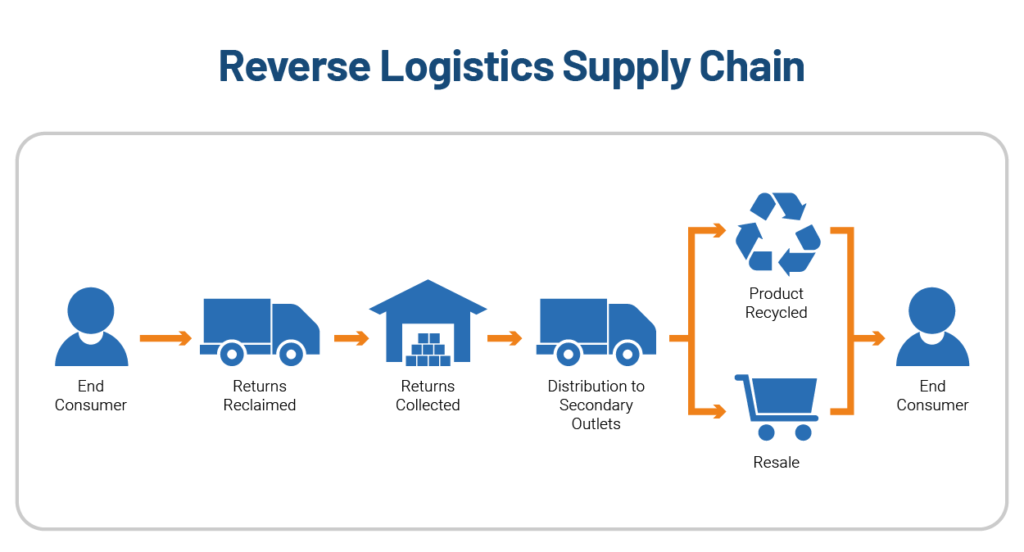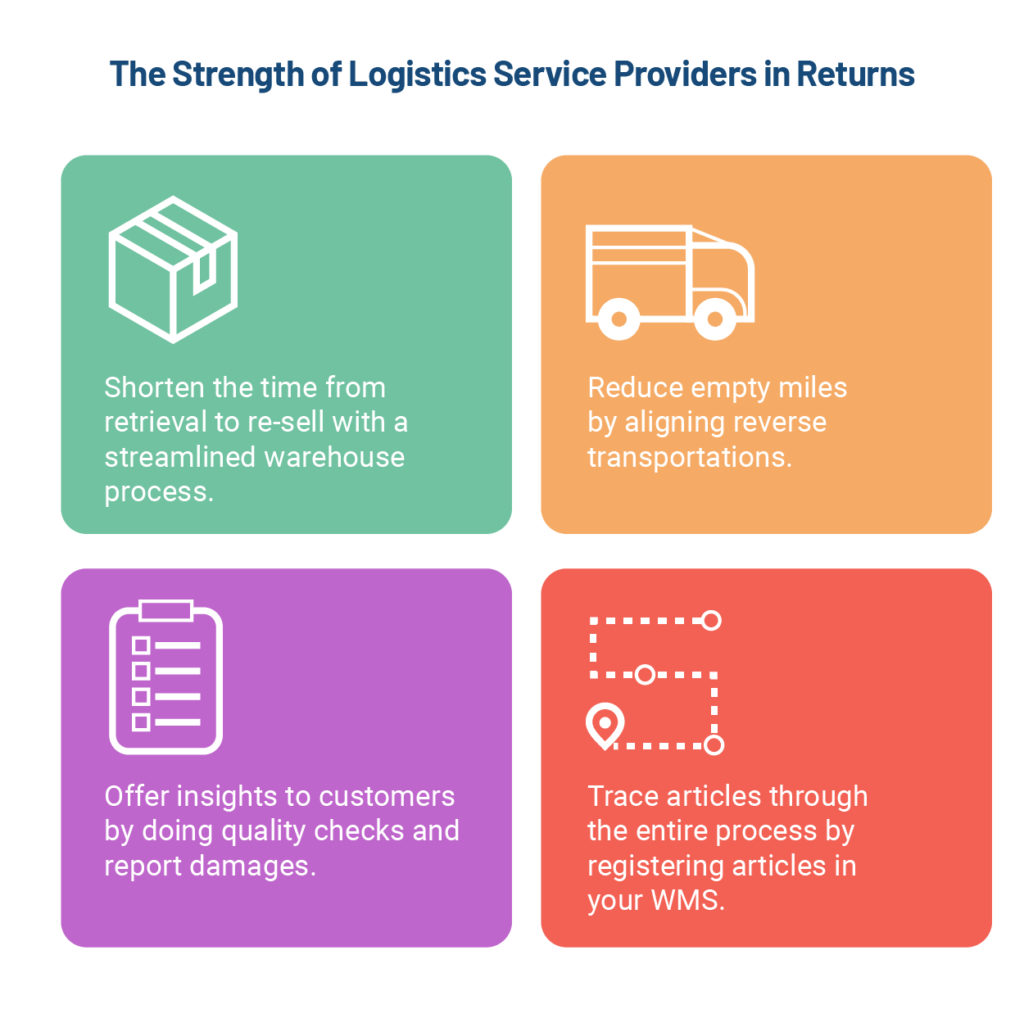
4 Ways to Reduce Your Reverse Logistics Costs
Time to read: 6 minutes
Typically, we associate it with delivering products to our customers. However, one crucial component of effective logistics is returning goods. It’s a resource-intensive process, returning items from end users to the producer or warehouse. Using reverse logistics, businesses can recover value from items transported incorrectly or in poor condition. In reality, reverse logistics is an integral aspect of eCommerce fulfillment. Also known as returns management, it is equally essential to efficient supply chain management as traditional “forward” logistics.
The movement of goods in the supply chain in the “opposite direction” is reverse logistics. It is the process of gathering, examining, and handling the returns of goods previously ordered and shipped to clients. There is more to reverse logistics than merely receiving returned merchandise. It also covers every step of handling returned merchandise. eCommerce merchants must gather, store, inspect, repair, or repackage the items before redistributing them across the supply chain for future sales.
Why You Need to Properly Manage Reverse Logistics Costs
Reverse logistics activities, which include the return of goods and materials, are vital to reducing production costs. Remanufacturing may be achieved by utilizing fewer raw resources and reusing materials from the same products. It has the desirable effect of lowering the price of the raw material flow required for production.

Reverse logistics satisfies the need for additional value that every successful business seeks to give its clients. Reverse logistics facilitates the customer’s return of a previously acquired item for repair or exchange.
Additionally, reverse logistics supports a sustainable and healthy environment. Online merchants hope to bring less environmentally damaging products to waste disposal facilities. Doing this means less hazardous materials taking up space in the trash.
eCommerce businesses need to be aware that returns can be costly. With eCommerce’s explosive growth, many new purchases are also being returned. Nearly 30% of all bought online products are being returned, compared to only 8.9% in physical retail stores. Your business risks losing money if it doesn’t have robust reverse logistics procedures. Subpar product management can have a detrimental effect on the environment.
Streamlining product movement in your supply chain will save you money and increase sustainability while keeping your customers happy.
Improved Customer Satisfaction
Customer satisfaction is one of the most important variables affecting the success of your business. Acquiring new clients is far more expensive and complex than keeping your current clientele. Ninety-two percent (92%) of customers are more likely to make another purchase from a shop if they had a positive return experience. Consider offering complete refunds and free return postage to help facilitate the process. The costs you incur then can be offset by the potential for repeat business.
Bigger Margin for Profits
Even if you have a large volume of returns, most of the merchandise will still be in excellent condition and readily resellable. Thus, the impact of an efficient reverse logistics process on your bottom line can be substantial. Returned items can be promptly accepted, examined, and fixed before being put back into stock and sold again.
Sustainable Practices
Most products returned throughout the supply chain are not faulty or disposed of. As mentioned above, many of them can still be used. For instance, you may prolong the life of your current products if you find new uses. This includes using some of their parts for repair or manufacturing. Reverse logistics, when used properly, can decrease waste. A more environmentally friendly impact can significantly increase customer loyalty and brand image.
Breaking Down Reverse Logistics Costs
Many online businesses have seen great success when it comes to selling products over the internet. However, the cost of handling returns can be staggering. In 2022, products returned to the U.S. reached a total value of $817 billion, which accounts for 16% of total retail sales. Before optimizing your reverse logistics process, you must understand where these reverse logistics costs come from.
Transportation
Returning a product from a customer to the manufacturer or warehouse might incur substantial costs. Businesses may not always have access to bulk shipping discounts in these situations. You’ll need to find other ways to save money on single returns. Return logistics make up about 60% of total transportation costs.
Processing
Processing the returns costs businesses about 66% of the item’s original price. This includes inspecting, testing, sorting, and repacking returned items. It’ll increase the workforce needed to handle requests, track returns, and process claims. In turn, customer service costs rise with the number of returns.
Restocking
Returning a product to your inventory comes with several expenses. Refurbishing, repackaging, and relabeling items must be considered when a returned product is put up for sale again.
Disposal
Reverse logistics costs might entail returning goods for disposal or recycling. Sorting, moving, and discarding the proper objects will incur work and expenses that merchants must factor in. Of course, the chance to resell returned goods can be considered a lost business opportunity.
Four Strategies to Cut Down on Reverse Logistics Costs
The key to excellent reverse logistics is simple: satisfied customers are devoted customers. Online shopping and fast delivery are now a part of our everyday lives. Customers are seeking hassle-free, simple, and convenient online returns. Managing return orders effectively might be the difference between a one-time and repeat client. It becomes evident that having effective reverse logistics can positively impact brand image and repeat business. In addition, it can minimize expenses.

No way back: the march of reverse logistics – Boltrics
1. Have Clear and Robust Return Policies
Easy and intuitive return policies can reduce the time and cost of return procedures. Managing customer expectations is easier when you have clearly defined rules and guidelines regarding item returns.
Customers want choices. Design your return policy to encourage customers to choose your preferred return method. Encourage in-store returns by offering free returns only available in-store. Retailers can positively influence consumer behavior by charging for the least desirable (and most expensive) return method. Offering cheaper or free returns for your preferred and least costly return method
2. Visibility & Transparency Across the Supply Chain
Many eCommerce businesses stop tracking progress once the product is delivered. Completed deliveries are usually a reliable indicator of profits and overall customer satisfaction. But it isn’t always the end in every situation.
Your operations will become fully transparent once you view every conventional forward logistics activity and every reverse logistics procedure. It makes it possible to monitor a product’s performance across its whole life cycle. This way, you can effectively spot areas in need of improvement. Without this transparency, It is hard to control and manage your supply chain activities holistically.
You should gather all the information on your return procedures to determine why customers return items. You may utilize this information to promote the goods that have the fewest returns and to make the required changes to your sales, logistics, and product offerings.
3. Optimize Your Inventory Management
Proper inventory management can reduce the quantity of stockouts and overstocks that result in returns. Your investment is increasingly locked up the more inventory you have in the warehouse. Have inventory management software automate product returns and inventory updates. Speed up product replacements and return shipping. You’ll also receive essential inventory data, which will help you make faster and more meaningful decisions.
4. Implement Circular Practices
Reusing or recycling old or undesirable materials to create new goods is known as circularity. It can lower production costs and lessen the environmental impact of a retail business.
Customers may choose to swap their purchases for different items if dissatisfied. This may reduce the quantity of goods you need to return. Another useful way to repurpose the returned goods is to trade them for brand-new ones.
You can even recycle the materials used to make a product if it is beyond repair. This is an excellent method of increasing revenue while cutting reverse logistics costs.
When calculating a product’s overall cost, reverse logistics costs are often overlooked. You can improve your bottom line and avoid unforeseen expenses if you identify some of these variable hidden charges. Successfully incorporate reverse logistics into your operations with appropriate planning and analysis. Reusing returned goods may increase your profitability and provide better customer service. A strong foundation for proper reverse logistics control starts with suitable protocols and procedures in place.
ZhenHub offers tech-driven logistics solutions to help keep your reverse logistics costs down. Our global network of fulfillment centers is ready to process your business’ product returns. Get real-time data on our dashboard when you sign up for free. Contact us to learn more about how you can use logistics technology to optimize your reverse logistics.

